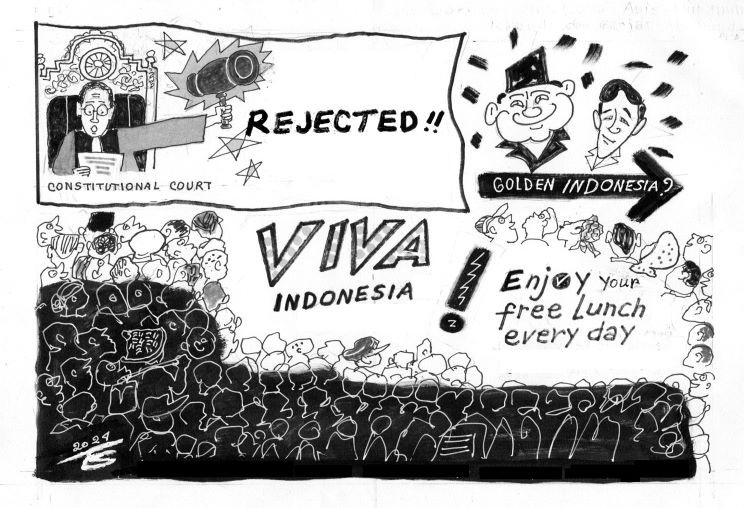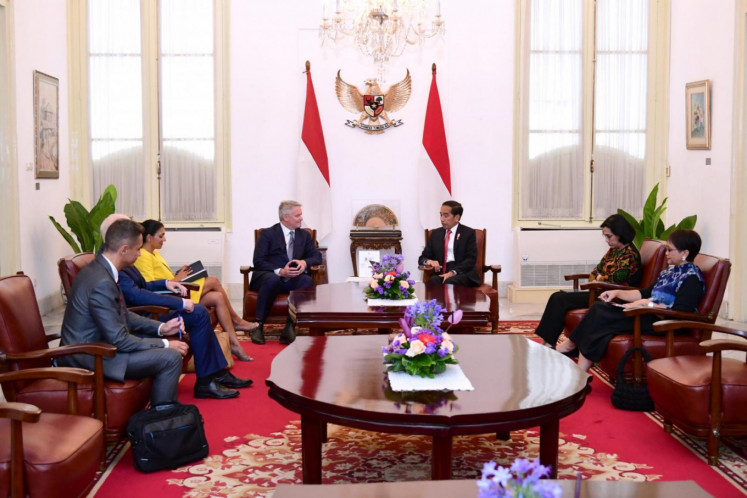Some issues around maize production data
Change Size
 Agriculture Minister Amran Sulaiman (from right), State-owned Enterprises Minister Rini Soemarno, Villages, Disadvantaged Regions and Transmigration Minister Eko Putro Sandjojo, West Java Deputy Governor Dedy Mizwar, Ciamis Regent Iing Syamarifin and Bank Mandiri president director Kartika Wirjoatmodjo pose for photograph after taking part in the paddy harvest event in Ciamis, West Java on Oct. 9. (Antara/Adeng Bustomi)
Agriculture Minister Amran Sulaiman (from right), State-owned Enterprises Minister Rini Soemarno, Villages, Disadvantaged Regions and Transmigration Minister Eko Putro Sandjojo, West Java Deputy Governor Dedy Mizwar, Ciamis Regent Iing Syamarifin and Bank Mandiri president director Kartika Wirjoatmodjo pose for photograph after taking part in the paddy harvest event in Ciamis, West Java on Oct. 9. (Antara/Adeng Bustomi)
I
n the second presidential debate covered topics on energy, food, infrastructure, natural resources and the environment on Feb. 17, president Joko “Jokowi” Widodo made a mistake in quoting data of maize importation.
The president said the import quantity of this commodity had dropped substantially from 3.5 million tons in 2014 to merely 180,000 tons in last year. In contrast, the official data from Statistics Indonesia (BPS) pointed out a more towering figure. During 2018, the quantity reached at 730,918 tons instead.
This minor mistake suddenly became a headline in newspapers. However, it seems that the public did not realize (or maybe did not know) that the real problem was not the import data quoted by the president, but the production data used as a based for the government to justify triumphant in boosting the country maize production, especially over the last four years.
When it comes to the accuracy of production data, maize has the same issue as rice, i.e., an overestimation. It could be explained since the production figure of two commodities has been collected through the same method since 1973. The calculation relies on a framework that combines two different data collection systems, i.e., the administrative report for collecting the harvested area information and a statistical method (survey sampling) to estimate productivity (yield per hectare). The Ministry of Agriculture (MoA) is responsible for the administrative report collected monthly at sub-district level by regional officers called "mantri tani or KCD" while the BPS is in charge of the estimation of productivity.
Technically, production data is just a multiplication of the harvested area and productivity. Collected by subjective measurements, mainly "eye-estimate", the former variable has been suspected of suffering from overestimation. Whereas, the reliability of the data of the last variable is better as collected through an objective measurement so-called "Survei Ubinan" or Crop-Cutting Survey. However, the issue of overestimation for rice was resolved last year by the implementation of a new method so-called Area Sampling Frame (ASF). So, what is going on with maize production data?
Taking into consideration the issue of overestimation on the harvested area measurement, the BPS has put off the dissemination of the production data of paddy and secondary food crops including maize since 2016. However, during the suspension period, the harvested area of maize, as well as the production figures, were still calculated using the old framework. The reason is that the MoA still needs the information for policy purposes, mainly for planning and evaluation of all programs designated to achieve self-sufficiency.
Somehow, the data was also circulated publicly, and all of us could see that the maize production data has experienced an unprecedented upward trend since 2015. Based on data published by the MoA as quoted by kumparan.com (16/02) for instance, the increase in maize production reached more than 10.5 million tons (53 per cent) just in three years, from 19.6 million tons in 2015 to 30.05 million tons in last year. It means that, on average, there was more than 3 million tons increase per year. The main contributor of this upswing, of course, a surge in the harvested area from around 3.8 million hectares in 2015 to about 5.6 million hectares in 2018.
Although at the same time, the quantity of imported maize has plunged from 3.35 million tons in 2015 to only 730,918 tons in 2018 as the impact of production increase, there is a strong indication of overestimation in the production data due to the weaknesses in the harvested area measurements.
The MoA stated that the total of maize consumption in last year reached 15.5 million tons. To be consistent with the production figure of 30.05 million tons, it means that there was a substantial amount of production surplus, which was about 14.6 million tons, last year. If it was true, the country should be a net exporter of maize instead of importing 730,918 tons from overseas.
A symptom of overestimation was also well captured by the results of the Inter-Census Agricultural Survey (SUTAS) conducted by the BPS last year. Even though the SUTAS used a recalling method that possibly suffers from underestimation to collect the information about the harvested area and production of maize from the farmers, the survey pointed out that 30.05 million tons of maize production is too high and does not make any sense.
So, how to fix the problem? It is clear that the chronic problem in the harvested area measurement must be cured. Therefore, objective measurement has to be developed to replace the old existing method. However, it is easy to say but difficult to implement. The primary challenge is the characteristics of maize cultivation itself. Most of the maize cultivations in Indonesia are conducted in small pieces of land scattering all across the country. The crop is also planted seasonally depending on the farmer's preference, which is determined by many factors. As a consequence, the availability of reliable information regarding the area of lands that are specifically dedicated to maize cultivation permanently becomes a big issue.
At the time being, the BPS in collaboration with the Agency for the Assesment and Implementation of Technology (BPPT) are developing ASF for maize. Nevertheless, it is not an easy task due to some issues around the maize cultivation, mainly land information as mentioned above. Therefore, other options that also make use of remote sensing technology such as radar technology should be considered. On top of that, there are some other critical issues other than the harvested area data that should be mindful of, such as a reliable maize consumption data and some conversion rates applied to obtain production figure, which needs to be updated.
Post-harvest technology must also be improved. It is critical for not only reducing the losses during post-harvest activities but also advancing the quality of corn of the farmers to meet the market standard. Most of the corn consumption comes from the industry sector, mainly the animal feed industry that has a specific qualification regarding the quality of the product such as aflatoxin and moisture contents. Sometimes, the farmers are not able to fulfil those standards leading to importation although the commodity is available domestically.
***
The writer is a data analyst at Statistics Indonesia and completed his Master’s Degree in applied econometrics at Monash University, Australia. The views are his own.









